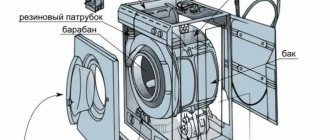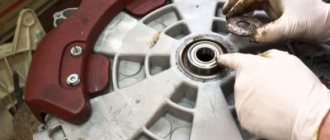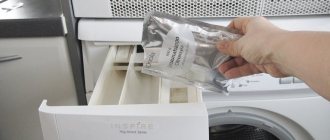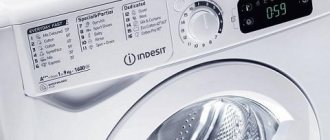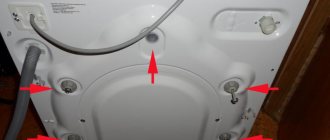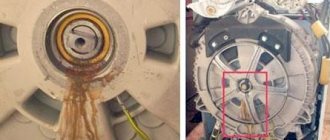What are shock absorbers and dampers?
Dampers are used in more modern washing machines.
They differ from shock absorbers in that they consist only of a spring. The shock absorber has a more complex design. Shock absorber device:
- Cylinder.
- Return spring.
- Piston with rods.
- Gaskets.
This type of shock absorber is called spring-piston, and is a cylindrical metal device containing a bushing. The rod moves in it during operation. On its upper part there is a special fit for rubber inserts, with the help of the latter it is connected to the drum.
A piston with a gasket is fixed at the base of the rod. It is impregnated with a special lubricant, which does not dry out for a long time and increases the friction force during movement. The work of the shock absorber is as follows:
- With sharp jumps, linear movement of the rod occurs.
- The piston, pushed by the rod, moves inside the cylinder.
- Lubrication creates the necessary conditions for movement so that it does not slip idle.
- When weakening occurs, the rod returns to its original position.
And everything repeats itself again.
The dampers have the same cylindrical design, only there is only a piston inside the cylinder, and there are holes in the walls for air to escape. The piston is equipped with a gasket that replaces the lubricant in the shock absorbers.
Dampers are divided into two types:
- Collapsible. They replace the compressed liner.
- Non-separable. The damper must be completely replaced.
The load that both of these devices can withstand varies from 100 to 150 newtons.
Design features of dampers
Dampers in washing machines are also used in combination with suspension springs, but their structure does not contain elements that are not very strong. In fact, this is also a steel cylinder, although it is not a rod with a piston that moves through its cavity, but simply a piston with holes in the walls to remove excess air.
The damper piston is also equipped with a friction-type gasket. It is made of porous polymer and impregnated with a non-drying lubricant that creates additional friction. There can be two or even more gaskets in the damper, it all depends on the characteristics of the device.
Both the metal cylinder and the damper moving along its cavity are equipped with rubber bushings on the outer edges, with the help of which the shock-absorbing devices are connected to the bottom of the machine and to the tank.
Dampers are available in two versions:
- Collapsible. To repair this type, most often it is enough to simply replace the pressed gasket.
- Non-separable. Their edges are rolled. Repair of this type consists of replacing the device.
The values of the maximum permissible force possible for a particular shock-absorbing device are indicated on the damper or shock absorber housings. Typically the load varies in the range of 50 - 150 newtons. When operating in the manufacturer-guaranteed mode, washers rarely exceed these limits.
Option 1: disassemble the case
- Unplug the machine and turn off the water supply.
- Open the laundry hatch. Remove the clamp - a ring with a screw or spring that tightly secures the rubber seal:
- on screw ones - loosen the screw;
- on spring ones - pry the spring with a screwdriver and pull it towards you.
- Bend the edges of the cuff seal and pull it out. Behind the cuff in the right center there is a block from the machine door lock wires - this also needs to be disconnected.
- Open the drain filter plug at the bottom of the machine. Disconnect the drain hose. Unscrew the screw that holds the casing and remove the casing. Then remove the screw that secures the front panel.
- Let's move on to the back of the machine. Unscrew the two top screws that hold the washer cover in place. Remove the cover - pull it towards you, lifting it up a little.
- Pull out the powder tray. There are two more screws under it - unscrew them.
- Remove any existing screws behind the control module panel.
- Carefully lift the control panel up. You will know that you have removed it when you hear the characteristic click of the latches. Once you have the panel in your hands, place it on top of the machine without removing the wire.
- Remove the screws holding the front panel. Slide the panel itself up and pull it out.
- Access to shock absorbers is open! Take pliers and remove the fasteners - the plastic “fingers” on the top and bottom of the part. Remove the parts from the supports.
- Install new parts.
- Reassemble the machine in reverse order.
If you can’t easily get to the necessary details, move on to option 2.
More nuances of disassembling washing machines are in a separate article, here.
Universal instructions for disassembling washing machines: 23 videos for all brands
Replacement procedure
Let's find out how to replace the shock absorbers of a washing machine with your own hands. You will need a screwdriver and a set of wrenches. First you need to get easy access to them. On some models, simply remove the back cover. If your shock absorbers are located in the front, then you will need to complete the following points:
- Remove the bolts and then remove the top cover of the washing machine.
- Remove the powder receptacle and the bottom plastic panel. Be careful! Do not damage the wires.
- Remove the cuffs and release the metal clamps.
- Unscrew all the bolts by removing the front part of the machine.
- Remove the wires or the door lock completely.
- Dismantle the façade of the building.
- At the bottom of the machine on the sides there are shock absorbers. Unscrew the bolt that secures the element to the body or remove the latch (depending on the specific model).
- Disconnect the shock absorber from the tank in the same way as described above.
- Install the new part and then reassemble in reverse order.
In the worst cases, it will be structurally impossible to disconnect the shock absorber from the tank. Then you just have to completely remove the tank. This is a rather complicated procedure. If you do not want to cause additional damage, contact a professional. When purchasing new parts, it is recommended to pay attention to the article numbers to be sure that the product is compatible with the model of your machine.
Replacing shock absorbers with removing the tank
The second option requires almost complete disassembly of the entire washing machine. To do this, it is necessary to remove all protective covers and the upper part of the housing, and then remove the powder tray. If there is a top part of the control panel, you need to remove it too. After this, you need to remove the springs and disconnect all the terminals from the tank. After this, you need to remove the tank and replace it according to the repair manual for the specific washing machine.
READ MORE: Best oral irrigators 2021. 10 best oral irrigators – 2021 ranking
It is worth noting that such repairs require quite a lot of physical strength and good skills in handling equipment. If this is your first time repairing a washing machine, then it is best to refrain from this endeavor and carry out easier repairs in the future. In a situation where the tank is removed, you need to contact a specialist or even buy a new car, because... such repairs can cost up to 80% of its cost.
Replacing shock absorbers without removing the tank
In the first option, shock absorbers can be replaced without removing the tank. To do this, you need to disconnect the machine from the power supply and water supply system. After this, you need to put the device “on its butt,” remove the front part of the body (if possible) and, using aerosol lubricant, screwdrivers and wrenches, remove the old shock absorbers.
After you have removed the old components, you should contact either an official spare parts dealer or a specialized store. Ideally, write down the complete model and serial number of the machine, take the removed parts with you, and speak with the seller in person, who can select the necessary replacement parts.
The final phase is to assemble the machine, connect it to water and electricity, and then proceed to test its functionality. Moreover, it is important not only to check the machine with an empty tank, but also to carry out an additional wash cycle with the tank loaded to find out how well the shock absorbers cope with their task.
The device of spring shock absorbers
One of the most common types of shock absorbers for washing equipment has the so-called spring-piston design. To put it in exaggerated terms, it is a metal cylinder with a polymer sleeve at the top. It directs the movement of the rod installed in the shock absorber.
The upper part of the rod is “sharpened” to fit polymer liners and rubber gaskets, with the help of which it is connected to the drum. Attached to the base of the rod is a piston with a gasket heavily impregnated with non-drying lubricant. This lubricant is needed to increase the friction force when the rod and piston move through the cavity of the steel cylinder.
The main structural components of a spring-piston shock absorber include a metal cylinder, closed at the top by a bushing, and a polished rod with a piston
The operation of a spring-piston type shock absorber includes a number of sequentially repeated actions:
- During sudden vibrations, the shock absorber rod is set into linear motion.
- The piston pressed by the rod moves along the cylinder cavity.
- Impregnation prevents the piston from slipping without appropriate force.
- When the pressure is released, the rod returns to its original position.
- When effort arises, everything repeats.
To ensure that the air in the cylinder does not create additional resistance, the piston is perforated. When you press on it, a possible air lock can easily come out through the holes made through it.
The load that appears during rotation of the drum puts pressure on the rod, which in turn pushes the piston fixed at its base along the steel cylinder
Of course, such a mode of operation does not give reason to hope for the eternal preservation of parts rubbing against each other in their original technical condition. At first, just play appears, then wear. Moreover, only one spring support can be damaged, and there are 2 to 4 of them in different modifications of washing units.
To remove the air plug located inside the cylinder, holes are made in it (Fig. on the left). At the top, the shock absorber rod is equipped with a seat for rubber gaskets and polymer inserts, through which it is attached to the washing machine tank
The operating principle of shock absorbers for washing machines of different brands is similar, but there are some design nuances. Their size, angle of inclination, location may differ; not in all models of washing equipment they are supplemented with springs holding the drum on top.
Instead of a pair of suspensions located on top, small springs can be used, connected to a nearby upper counterweight.
In other layout options, the tank, consisting of two parts, is supported by dampers from below instead of shock absorbers. This design type is classic, therefore it is also very worth understanding the structure of these devices. It is possible that this is exactly your case.
The motor in the modification of the washing machine shown in the diagram is mounted at the top. There is no need to disassemble it completely to replace shock absorbers; just remove the side or rear part of the body
Replacing suspension springs
Another shock-absorbing element is steel springs, with the help of which the drum is suspended inside the housing. They are located in the upper part of the machine body. These are quite reliable elements, the replacement of which is required extremely rarely. Sometimes the spring hooks pop out of the eye holes due to vibration; to easily install them in place, just lift the drum.
Not only the quiet operation of the washing machine, but also protection from vibration loads of other elements depends on the reliable operation of the dampers. If shock absorbers break down, it is best to replace them in a service center with a warranty.
Typical causes of breakdowns
Depending on the settings, the brand of the unit and the functions performed, the washing machine drums make from 700 to 1800 revolutions per minute. Such an impressive load, and even with the application of rotational force, can easily damage contacting parts and weaken components and connections.
If shock absorbers had not been developed to dampen the vibration of the drum and the tank containing it during the spin period, the machine would have to be repaired after each washing “session”. Their purpose is no different from the functions of similar car devices.
Shock-absorbing devices of washing machines perform work equivalent to similar parts of cars. They are designed to dampen the vibrating movements of the tank during the spinning/washing process ( )
Shock absorbers, coupled with suspension springs, eliminate direct contact between the machine’s tank and its metal body, steel and plastic parts. In the form of original supports, they are located under the main rotating part of the equipment, which is fixed in the upper part of the unit by hanging springs.
READ MORE: Smart diagnostics of Elgie washing machine: what is it? —
During operation of the washing machine, the supports and springs are unstable, due to which the drum, rotating at breakneck speed, can slightly shift relative to its resting position.
Those. These devices, performing spring movements, provide the drum with the ability to make the required rotations according to its status, without transferring the load to adjacent parts and assemblies.
The tank of the washing unit is suspended from above using springs, from below it rests on shock absorbers or dampers, which prevent the transmission of vibration from the drum to the body of the machine
The structural components of the washing machine, protected from vibration by shock absorbers, last much longer and are less likely to fail. True, the shock-absorbing devices themselves gradually lose their original strength during the execution of the assigned task.
Worn-out devices may require repair or replacement at an extremely inopportune moment, for example, before an evening wash, the timing of which does not allow calling a technician urgently. Or we will have to wait quite a long time for his arrival. This is where you will need information about the specifics of restoring shock absorbers and their structure.
If there is an urgent need to repair shock absorbers, work on their repair or replacement can be done with your own hands
How to repair washing machine shock absorbers
New vibration dampers for modern cars cost from 500 to 3,000 rubles per pair, depending on the model. Although this amount is not critical, in some cases it is possible to restore the old shock absorber. Owners of washing machines simply remove the remaining sealing elements from the body. Using the selection method, homemade parts from cut rubber pipes, leather belts or pieces of linoleum are installed in their place.
The main thing with such a restoration is to achieve a high-quality seal of the connection of the rod in the body. The cut parts are fixed in the body; for smoother operation, the connection is lubricated with technical or other grease. This type of repair can hardly be called reliable. In the best case, such a damper will last several dozen washing cycles, and malfunctioning or jamming will lead to breakage of other parts.
With modern repairs, the faulty damper element assembly is replaced with a new one, and both shock absorbers must be replaced, even if one of them is in perfect condition!
Breakage of shock absorbers/dampers
The situation when the machine jumps or “travels” around the apartment during washing can be caused by natural wear and tear on the shock absorbers. These parts are used to dampen vibrations (depreciation) that occur when the machine operates at high speeds.
You can check their condition by removing one of the walls of the washing machine. Washing machines can use dampers or shock absorbers.
Each of the shock absorbers has its own “stroke”, designed for the force exerted by the washing machine. Faulty shock absorbers cannot provide the required force. To check the serviceability of the shock absorber, you need to disconnect one of the ends of its fastening and check it manually. A damaged shock absorber moves lightly, causing strong vibrations during spinning. To restore normal operation of the washing machine, the faulty part must be replaced.
Fixing shock absorbers
To fix shock absorbers, two types of fastening can be used - plastic bushings with latches or bolts. In order to remove damaged parts, you need to unscrew the bolts or, by pushing in the latches, remove the plastic bushings. Installation of new shock absorbers is carried out in the reverse order. It is worth considering that both shock absorbers need to be replaced at once - this is necessary for normal load distribution.
Dampers, unlike shock absorbers, do not have their own “stroke”. The stroke of the dampers is ensured by a movable tube or plate connected to the tank in the damper plates.
Increased vibration and jumping most often occur due to the failure of plastic linings covering the plates or tubes that extend from the tank. To replace the plates, the damper must be removed. The damper is fixed to the machine body using screws that need to be unscrewed. After this, you can remove the broken covers and install new ones in their place.
How to repair a broken shock absorber
We warn you: self-repair, lubrication, or installation of a repair kit will only help for a while. It is safer to replace the shock absorbers for your washing machine with new ones than to try to restore them.
Let's assume you have already disassembled the machine and removed the necessary parts. Let's make a new gasket instead of the old one:
- Take a flat-head screwdriver. Press the plastic ring onto the part.
- Now you have access to the rubber gasket in the lubricant. Get it out.
- Clean the entire shock absorber thoroughly.
- Take a leather belt and cut 2 strips from it. The length and width of the strips are based on the gasket. The thickness of the strips should be 3.5 mm. The length should be “overlapping” so that the strips form a “ring” inside the part.
- Check the density. The rod - the metal sleeve - should move with noticeable force.
- Put a little thick lubricant inside so that the spare part does not rust and the movement is not “dry”.
- Reinstall both parts. Assemble the machine.
READ MORE: Rating of the best vertical vacuum cleaners of 2021 - which one is better to buy and why.
How to check when purchasing and replace a shock absorber?
When buying a new part, as well as when dismantling an old one, you need to compress the damper several times. If the compression is tight, then everything is in order. If it is easy, this indicates wear of the seals.
Important! Two elements are changed at once, regardless of the degree of wear.
Now you know how to restore and repair shock absorbers in a washing machine. If you don’t want to bother with repairs, then buy a new set of spare parts and install them in the washing machine.
How to remove and check shock absorbers from a washing machine
All damping elements are protected by the body and lining; in order to get to the damper mounts for different models of washing machines, different disassembly approaches are required.
When replacing dampers on a washing machine, there is no need to completely disassemble it. For example, to provide access to shock absorbers on Bosch washing machines, simply remove the front cover. In these models, the dampers have a classic single-bolt mount, located at the bottom of the unit. The upper part of the attachment to the tank is held on by latches that are part of it.
In order to remove the shock absorber from the tank, the connection is drilled with a long drill with a diameter of 13 mm, then you need to remove the part through the front of the machine.
On some LG models, you do not need to remove any covers to remove the damper. To do this, just put the unit on its side, having previously disconnected it from the power supply, water supply and sewerage. The shock absorber is secured on both sides with plastic pins with locking latches. By pressing the latch, you can easily remove your finger from the hole, freeing it from the fastening. If the finger is very difficult to remove, you can use a special tool such as a car VD shk.
In Samsung washing machines, bolts of size M8 or M10 are most often used to secure dampers. They are unscrewed using spanners or socket heads, 12-13 mm in size. Bolt-on mounting is used on models from Miele, AEG and many other manufacturers. In Wirhpool models, the shock absorbers on both sides are fastened with special latches; by pressing them, you can freely remove the damping elements.
Regardless of the method of fastening, removal must be done carefully, without using an impact tool that could damage the plastic tank or other elements of the device. Checking the damper is carried out by simply pressing the rod and pulling it out of the body. In this case, there should be noticeable resistance to pressing by hand.
If the rod extends freely and there is no lubrication, and traces of rust are visible inside, we can talk about wear and tear and unsuitability of the shock-absorbing devices.
Washing machine shock absorbers: how to remove, change and repair it yourself
Shock absorbers (dampers) are devices included in the design of a washing machine, designed to dampen (dampen) vibrations that occur during washing. If the washing machine has strong vibrations or uncharacteristic knocking noises, then most likely the shock-absorbing devices have failed. Shock absorbers were used in old car models, but modern cars use dampers, they are similar to each other, their only difference is the absence of return springs. Dampers are located at the bottom of the unit under the tank, and springs are installed at the top of the housing to suspend the tank.
Quality of components
We should also talk about the quality of components that will be used to repair the washing machine. Unfortunately, most manufacturers supply original spare parts at a very high price, which significantly increases the cost of repairs. Most craftsmen use low-quality fakes, passing them off as original products, thereby earning more money from their services.
We strongly do not recommend installing such shock absorbers, because... they can quickly fail and damage the bearing block, which in turn will result in even more expensive repairs. If a master wants to install Russian or Chinese shock absorbers, you need to study reviews about them on the Internet and install them at your own peril and risk. High-quality repairs can only be achieved using original components.
Causes and symptoms of malfunction
Malfunctions in the operation of washing machine dampers occur for the following reasons:
- Wear of mating elements (o-rings);
- Long-term loads and vibrations;
- Drying of the lubricant inside the cylinder and violation of operating rules. Branded shock absorbers in Samsung, LG, Siemens, AEG, or Ariston washing machines usually last 5-7 years without any visible disturbances in their operation.
With constant overload of the washing drum, especially in spin modes, the service life of the damping elements decreases. You can determine that the shock absorber is faulty based on several signs:
- strong vibration of the washing machine body, especially at high speeds; characteristic knocking sound when washing;
- The engine drive belt constantly weakens and falls off;
READ MORE: Top 15 best steam cleaners for 2021 according to users
Due to the beating of the drum, its sealed connection with the rubber cuff is broken (for washing machines with horizontal loading) leading to water leaks.
There are several ways to check dampers for working condition:
- Remove the top cover of the washing machine. After removing the cover, press firmly on the washing tank, it should smoothly return to its place, but if the tank returns jerkily, this means that the devices are not working properly and require replacement.
- The second, more reliable way to check is to completely remove the shock absorbers from their seats.
Causes of shock absorber failures
In addition to natural wear, which is accelerated by the impact of planned loads from the drum, high humidity and temperature changes, shock absorbers in the machine can fail for the following reasons:
- Manufacturing defects. For example, poor quality gaskets. Everything is clear here: if the original condition of the part was not impeccable, then the more often the machine works, the faster the shock absorber will fail.
- Incorrect balancing of the entire unit during installation or during operation. This leads to an uneven distribution of loads between all shock absorbers and accelerated wear of the “springs”.
- Systematic overload of the machine tank or washing of things that can be subjected to wet automatic processing only in units with increased power, available in dry cleaners and laundries.
- Stopping the supply of electricity during spinning at high speeds. If before this incident the shock absorber was already on its last legs, then sharp braking of a heavy drum can be the last test for the “spring”.
Washing machine shock absorbers
Symptoms of failure
The most common symptom of shock absorber failure is vibration, which cannot be eliminated by leveling the machine. The longer it works in this state, the stronger the vibration becomes and the machine can even “dance” around the bathroom or laundry room. In this case, it is necessary to carry out repairs - replace the worn shock absorbers.
Some mechanics prefer to replace a worn damper seal or replace only one shock absorber. But we recommend changing the pair immediately, because... this will cause significantly fewer problems in future operation. If you replace only 1 shock absorber, the second one will fail faster and another repair will be required, which takes extra time and leads to additional expenses.
Replacing shock absorbers is a rather serious procedure that should be entrusted to specialists, because... Cars from different manufacturers are disassembled differently, have different mounts and brands of shock absorbers. Also, you cannot “randomly” change them for similar models of the same brand - shock absorbers are selected according to the permissible loading weight of the tank.
If you nevertheless decide to replace the tank yourself, then you need to collect a rather impressive list of tools: a set of screwdrivers and wrenches, a bolt organizer, aerosol lubricant.
Replacing a part if there is a malfunction
To repair the shock absorber yourself, it is recommended to remove the insert. See how the rod moves without the insert. If it moves easily, then the gasket is worn out. This is what needs to be replaced.
- From a belt three millimeters thick, cut a piece to the diameter of the device.
- Install it instead of the gasket.
- Lubricate to improve friction before installing the rod. It is recommended to use regular lubricating oil.
- Insert the rod back.
When a shock absorber has mechanical damage from wear or defects, it is better to replace it with a new one. Read and remember the brand and model of the damper and tell your dealer. Do not buy parts at random, they may not fit the machine.
It is best to go to the store with an old shock absorber. This method is more reliable. The seller will see the part and select the one he needs in return.
Important! Prices for shock absorbers are low, so it will be cheaper to replace the part yourself.
Repairing a washing machine shock absorber: diagnosing faults and replacing them yourself
Most people turn to appliance repair services, but the problem is that they charge a lot for replacing a small part. But much of this could have been produced by the owner himself, without turning to the craftsmen.
For example, any person can repair the shock absorber of a washing machine independently. The main thing is to be able to distinguish between shock absorbers and dampers, and to know the causes of breakdowns.
Troubleshooting
Shock absorbers prevent the device from sliding on the floor during washing and spinning. They reduce the vibration coming from the drum; without them, it would jump during washing, and the drum spinning at high speeds would damage the structure.
After many years of service, shock absorbers lose strength, so it is recommended to periodically carry out diagnostics, otherwise the washing machine may break at the most inopportune moment.
Diagnostics for vertical loading
If shock absorbers or dampers are damaged, a specific noise is heard - knocking during washing, coming from inside. Possible distortions of the housing or strong vibration.
Diagnostics for vertical loading is carried out as follows.
- Press the top of the tank with your hand. If you feel that there is no resistance, and after you remove your hand it continues to swing, then it is time for repairs.
- Watch how the drum rotates. If it’s tight or squeaky, it means the parts are not lubricated at all.
- Disassemble the machine, remove the cover from the back. Press down on the tank again and forcefully lower it down, then quickly release it. If the tank jumps and no longer moves, then the shock absorbers are normal.
These simple diagnostic methods will help you determine whether your washing machine's dampers need repair.
Front loading diagnostics
Diagnosis of a front-loading washing machine occurs in a different way.
- Press firmly on the tank at the top and look at the hatch seal lip. If folds form on it, then repair is needed.
- Be sure to note how much the tank drops as you press.
Normally, when pressing, folds should not appear on the seal and the tank should not sag when it is loaded.
If all these defects are found, the device should be repaired.
What are shock absorbers and dampers?
Dampers are used in more modern washing machines. They differ from shock absorbers in that they consist only of a spring. The shock absorber has a more complex design.
Shock absorber device:
- Cylinder.
- Return spring.
- Piston with rods.
- Gaskets.
This type of shock absorber is called spring-piston, and is a cylindrical metal device containing a bushing. The rod moves in it during operation. On its upper part there is a special fit for rubber inserts, with the help of the latter it is connected to the drum.
A piston with a gasket is fixed at the base of the rod. It is impregnated with a special lubricant that does not dry out for a long time and increases the friction force during movement. The work of the shock absorber is as follows:
- With sharp jumps, linear movement of the rod occurs.
- The piston, pushed by the rod, moves inside the cylinder.
- Lubrication creates the necessary conditions for movement so that it does not slip idle.
- When weakening occurs, the rod returns to its original position.
And everything repeats itself again.
The dampers have the same cylindrical design, only there is only a piston inside the cylinder, and there are holes in the walls for air to escape. The piston is equipped with a gasket that replaces the lubricant in the shock absorbers.
Dampers are divided into two types:
- Collapsible. They replace the compressed liner.
- Non-separable. The damper must be completely replaced.
The load that both of these devices can withstand varies from 100 to 150 newtons.
Washing machine shock absorber repair
Replacing shock absorbers in a washing machine can be done even by an amateur, without causing any harm to the machine.
Checking for serviceability
To repair the shock absorber of a washing machine with your own hands, you need to check which part has become unusable.
It is necessary to provide access to the damper part of the mechanism. It is recommended to place the washing machine on its side. Then follow the instructions:
- Unscrew the two bolts on the back of the machine that secure the top cover and remove it.
- Pull out the washing powder tray.
- Release the drain filter from the panel covering it.
- Remove the control panel. To do this, you will need to unscrew additional bolts and disconnect the wires.
- After gaining access to the cuff of the façade of the device, remove the securing clamp, and then the cuff itself. Push it inside the machine.
- Now it is recommended to detach the façade.
To determine whether the damper is worth replacing, it is recommended to compress it. If it compresses and unclenches very easily and freely, then the device must be replaced. If the structure is compressed with difficulty, the shock absorber will still work.
There are other reasons for device failure.
- The liner or gasket is worn out. Then replace the rubber part of the device.
- Mechanical deformation due to improper transportation. A replacement will be needed here.
- The bolts are worn out and the shock absorber is simply hanging on them. The bolts will need to be replaced.
Replacing a part if there is a malfunction
To repair the shock absorber yourself, it is recommended to remove the insert. See how the rod moves without the insert. If it moves easily, then the gasket is worn out. This is what needs to be replaced.
- From a belt three millimeters thick, cut a piece to the diameter of the device.
- Install it instead of the gasket.
- Lubricate to improve friction before installing the rod. It is recommended to use regular lubricating oil.
- Insert the rod back.
When a shock absorber has mechanical damage from wear or defects, it is better to replace it with a new one. Read and remember the brand and model of the damper and tell your dealer. Do not buy parts at random, they may not fit the machine.
It is best to go to the store with an old shock absorber. This method is more reliable. The seller will see the part and select the one he needs in return.
Important! Prices for shock absorbers are low, so it will be cheaper to replace the part yourself.
Restoring the operation of the washing machine after changing the shock absorber
Installation and restoration of the washing machine is carried out in strictly reverse order. Then put the machine in its normal position and try to press on the drum. If the shock absorber is installed correctly, the drum will not move like a pendulum after you remove your hand.
Now you can move on to washing your clothes.
Was it useful? Like it!
Washing machines from the gorenje brand
Instead of repairing an outdated washing machine that will inevitably break down in the future, you should consider buying a new machine from the famous Slovenian brand Gorenje. Devices from Gorenje compare favorably with other brands by their low consumption of water and electricity.
Such machines are low noise and have an increased level of reliability. The new machine will not only work for a long time, but will also improve the quality of washing due to the presence of a modern electronic control module that carefully controls all processes. Our catalog offers models in various stylistic solutions that will satisfy even the most demanding customers.
The device of shock absorbers and dampers of the washing machine
The friction shock absorber (1) is designed for centrifugal drum washing machines. The shock absorber contains a housing (2) and a movable pusher (4) installed in it parallel to its longitudinal axis (2a) and removed from the housing (2); at its end, located in the housing (2), a friction lining is movably installed.
The friction lining (8) or the body carrying the friction lining (8) is equipped with an installation socket (22) for receiving a spacer (23). The friction lining (8) is movably mounted on the pusher (4), the guide element (20) is pre-tensioned between the friction lining (8) and the guide surface or sliding surface (21) matched with it, and a spacer (23) is provided. to establish a frictionally effective geometric parameter (24) and/or to tension the friction lining (8) to influence the frictional force between the friction lining and the matched sliding surface. The spacer (23) is made in the form of a fixing or fastening element of the guide element (20) matched with the friction lining (8). 2 n. and 21 salary f-ly, 9 ill.
Similar articles:
- What do the icons on a washing machine mean: what symbols are on different brands of machines, photos
- Washing modes in a Zanussi washing machine
- How to turn off the beep? — Bosch SPV 40M20RU [Answers 1]
- A Quick Guide to Margherita 2000, Argherita | Ariston AL 109 X Operating Instructions | Page 2 / 14
Making a new gasket for the damper
If noise and significant knocking are detected in a washing machine with dampers, it is often enough to change the sealing gaskets. To do this, you need to partially disassemble the machine and simply disconnect the device.
Then, according to plumbing rules, you should simply cut out new gaskets from textolite or a piece of rubber of suitable thickness. After which the gaskets are replaced.
Only dismountable damper versions can be repaired. In most cases, it is simply necessary to replace the gaskets and bushings used in the connections between the device and the tank and the bottom of the unit
A used rubber brake pad for a car is ideal as a starting material for making your own gaskets. It is better to select the rubber thickness according to the actual size of the gap between the tank and the shock-absorbing device.
READ MORE: LG FH-2G6WDS3 reviews
